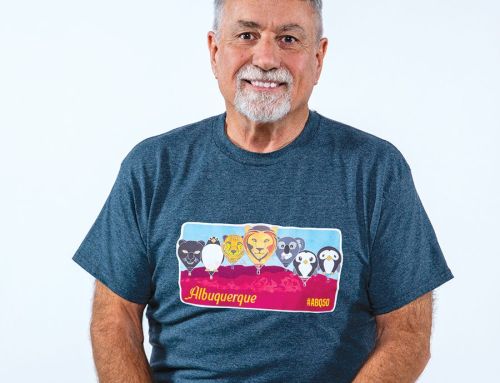By Akers Editorial
At Your Service
STORY: Leigh Neely / PHOTOS: Fred Lopez
Studies show that loving a pet is good for your health. From decreasing blood pressure to giving you a better outlook on life, owning a pet has many advantages. And those who have disabilities find that pets are not only furry buddies but are also vital lifelines to a normal life. They are the source of independence; they are essential.
Mickey, the cat in training
Owner: Kathy McDonald
Kathy McDonald of the Village of La Paloma has seen her share of skeptics who question whether or not a cat can really be a service animal. But for more than 18 years, her cat Dusty had the unique ability to warn Kathy when she was going to have an epileptic seizure. He would lick her neck, prompting her to sit down or move out of a public area. The two were featured in national news stories a few years ago about their special bond.
“When you’re about to have a seizure, doctors say there is an aura,” Kathy says, “and that aura has a distinct odor. That’s what the cat smells and how he knows something is wrong.”
Diagnosed with epilepsy at age 15, Kathy controls her disease with medications; however, a seizure occasionally occurs even while taking medication. It was Kathy’s niece, a nurse, who first noticed the cat was reacting before Kathy’s seizures. Learning Dusty could warn her ahead of time was a boon for Kathy, but when he died last year it was a big loss for Kathy and her husband, Ed.
“Dusty went everywhere I went,” Kathy says, “from Washington, D.C. to Niagara Falls to doctor’s offices and restaurants. He would sit on the front pew of our church and wait while I took communion. I could even drive with Dusty because his warning gave me enough time to get off the road.” In well-documented cases, cats have been astute enough to warn owners of carbon monoxide poisoning, house fires, earthquakes, and other medical situations like high blood sugar or impending heart attack.
“People don’t pay attention to cats,” Ed says, “but if you watch them, they’re very tuned in to what’s going on around them.”
 When Kathy went looking for a new cat to replace Dusty, she was also looking for help with seizure warnings. Her newest companion, Mickey, came from a breeder in Lake Wales, whose cats exhibit the traits needed to become a service animal. Ideal service cats are laidback, friendly, and comfortable with loud noises and unpredictable situations.
When Kathy went looking for a new cat to replace Dusty, she was also looking for help with seizure warnings. Her newest companion, Mickey, came from a breeder in Lake Wales, whose cats exhibit the traits needed to become a service animal. Ideal service cats are laidback, friendly, and comfortable with loud noises and unpredictable situations.
Mickey was three months old when Kathy began training him herself, which according to the Service Animals Registry of America (SARA) is legitimate. The organization also defines “signaling” as a form of work that an animal can do to qualify it as a service animal.
“Dusty was well behaved and easy to train. He walked on a leash and responded to commands,” Kathy remembers. “I was at Walgreen’s getting ready to pay, and I told Dusty to go sit in the chair. He went right over and sat down. The pharmacist was amazed.”
Now it’s Mickey’s turn to aid his owner. Like training a toddler, there must be repetition and reward. In the short time she has been working with Mickey, he is doing well at potty training, which will make it easier to take him out. They are also working with a harness and leash, but since Mickey is a kitten, he still resists.
Training isn’t the only challenge that Kathy faces in getting Mickey ready for his role as a service pet. In 2011, the Americans with Disabilities Act (ADA) was amended to recognize only dogs as service animals.
“I didn’t know about it until I received a phone call from The Villages telling me I could no longer take Dusty into the recreation centers or to the programs at The Savannah Center,” Kathy says. “I was shocked, but she told me the terms of the ADA had changed and they had to do what the law required.”
Kathy immediately called the ADA office and received the same information. The act reads, “Beginning on March 15, 2011, only dogs are recognized as service animals under titles II and III of the ADA. A service animal is a dog that is individually trained to do work or perform tasks for a person with a disability.”
When Kathy asked about a visually impaired woman who had a miniature horse as a service animal, she discovered the woman got a special dispensation. However, that was not an option for Kathy.
The ADA further says, “The ADA regulations define a service animal as any dog or miniature horse that has been individually trained to perform work or tasks for an individual with a disability. The task the service animal performs must be directly related to the person’s disability. Animals used to deter crime, provide comfort, therapy, or companionship alone are not considered service animals under the ADA.”
“It was devastating. Now I feel like I can’t go anywhere in The Villages,” Kathy says. “Ed can go with me, of course, but he has no idea if I’m about to have a seizure. He can’t warn me.”
Steve, the service dog
Owner: Virginia Mohl
Virginia Mohl’s dog Steve is more than a beloved pet. Virginia was born with congenital cataracts, a medical condition that refers to a clouding of the lens of the eye at birth. Though the disease is rare, it is hereditary. She and her two siblings have the disease, along with two of her three children and two of her grandchildren.
“I have been legally blind since birth. Back then, they did not do surgery until a child was 3 years old. Now they do surgery at two months or younger,” Virginia says. “I’m amazed at how far medicine has come. Two of my grandchildren were born with the condition, but they have almost normal vision because they had the lens implanted at a very young age.”
Originally from Dobbs Ferry, N.Y., Virginia was able to work from home as a medical transcriptionist despite being visually impaired. However, two years ago, she injured her good eye, making her vision worse.
“I stood on a stool to read the thermometer and when I got down, I hit myself with the corner of a book. It injured my cornea,” she says.
Never one to let her eye disease deter her, Virginia paid a visit to the Southeastern Guide Dogs in Palmetto, which provides service dogs to The Villages. As someone who belongs to a variety of clubs and is active in her Village of Virginia Trace neighborhood, she needed to find a new four-legged companion that would let her keep her independence. That is when she met Steve, a yellow Labrador retriever.
“I was in school 26 days with Steve. There were eight students in the class and they took each student and dog on an individual basis,” Virginia says. “The instructors are very dedicated. I cannot say enough good things about them. The school is just amazing.”
 At graduation, Virginia playfully told the crowd she was now taking the leash off her husband, Jerry. Jerry admits, however, there was some apprehension the first time Virginia went out alone with Steve. “But now, I don’t worry at all. Virginia has always been able to handle herself well, and with the dog, it’s even more so,” Jerry says.
At graduation, Virginia playfully told the crowd she was now taking the leash off her husband, Jerry. Jerry admits, however, there was some apprehension the first time Virginia went out alone with Steve. “But now, I don’t worry at all. Virginia has always been able to handle herself well, and with the dog, it’s even more so,” Jerry says.
Steve is a very loving and friendly dog that loves to play, but as with most guide dogs, strangers should not try to interact with him when his harness is on.
“He’s working when he has his harness on. People shouldn’t touch,” Virginia says. “When his harness is off, he’s just a dog. People don’t know what it means when I say he’s a working dog.”
Even to this day, Virginia remains amazed at the skill and insight of her dog. He responds to 40 commands. “In a store when I tell him to find the counter, he’ll walk me right up to the register, or if I tell him to find the door in a restaurant, he takes me right there.”
Marcie Davis, cofounder of International Assistance Dog Week, has her own guide dog named Whistle. “I always thought I was pretty independent until I got a service dog. I didn’t realize what I was missing, and my husband said he didn’t realize how it would change his life, too.”
Marcie has been paraplegic for more than 30 years and has had Whistle for the past 13 years. She coauthored the book Working Like Dogs: The Service Dog Guidebook with Melissa Bunnel. The book is a resource for those considering getting a guide dog or for owners. It has checklists, practical tips, and personal stories from individuals with service dogs.
“There is no regulatory agency for service animals, although there is an organization called Assistance Dogs International that is comprised of all the service dog training organizations,” Marcie says. “When you want a service dog, be sure the trainer is a member of this organization.”
Did you know?
- It takes $60,000 to train one guide dog.
- The Guide Dog Foundation provides service dogs to legally blind persons at no charge.
- The Seeing Eye is the original name of the Guide Dog Foundation, an international federation.
- Southeastern Guide Dogs provides dogs for The Villages, is accredited by the International Guide Dog Federation in Reading, England, and is a member of the Council of U.S. Dog Guide Schools. The school has provided more than 2,800 guide dogs since 1982.







































